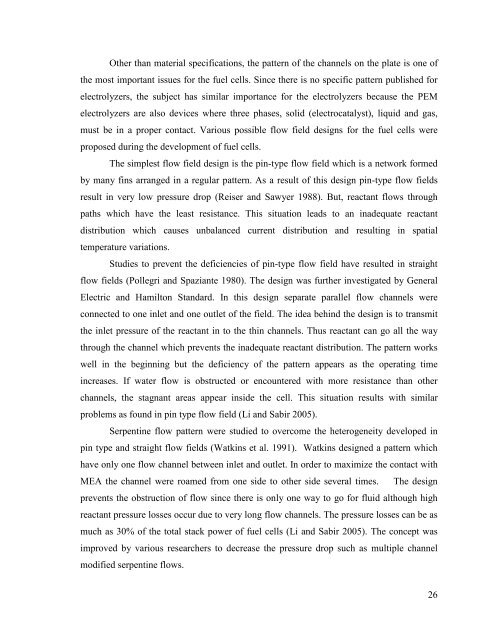hydrogen production from water using solar cells powered nafion ...
hydrogen production from water using solar cells powered nafion ...
hydrogen production from water using solar cells powered nafion ...
Create successful ePaper yourself
Turn your PDF publications into a flip-book with our unique Google optimized e-Paper software.
Other than material specifications, the pattern of the channels on the plate is one of<br />
the most important issues for the fuel <strong>cells</strong>. Since there is no specific pattern published for<br />
electrolyzers, the subject has similar importance for the electrolyzers because the PEM<br />
electrolyzers are also devices where three phases, solid (electrocatalyst), liquid and gas,<br />
must be in a proper contact. Various possible flow field designs for the fuel <strong>cells</strong> were<br />
proposed during the development of fuel <strong>cells</strong>.<br />
The simplest flow field design is the pin-type flow field which is a network formed<br />
by many fins arranged in a regular pattern. As a result of this design pin-type flow fields<br />
result in very low pressure drop (Reiser and Sawyer 1988). But, reactant flows through<br />
paths which have the least resistance. This situation leads to an inadequate reactant<br />
distribution which causes unbalanced current distribution and resulting in spatial<br />
temperature variations.<br />
Studies to prevent the deficiencies of pin-type flow field have resulted in straight<br />
flow fields (Pollegri and Spaziante 1980). The design was further investigated by General<br />
Electric and Hamilton Standard. In this design separate parallel flow channels were<br />
connected to one inlet and one outlet of the field. The idea behind the design is to transmit<br />
the inlet pressure of the reactant in to the thin channels. Thus reactant can go all the way<br />
through the channel which prevents the inadequate reactant distribution. The pattern works<br />
well in the beginning but the deficiency of the pattern appears as the operating time<br />
increases. If <strong>water</strong> flow is obstructed or encountered with more resistance than other<br />
channels, the stagnant areas appear inside the cell. This situation results with similar<br />
problems as found in pin type flow field (Li and Sabir 2005).<br />
Serpentine flow pattern were studied to overcome the heterogeneity developed in<br />
pin type and straight flow fields (Watkins et al. 1991). Watkins designed a pattern which<br />
have only one flow channel between inlet and outlet. In order to maximize the contact with<br />
MEA the channel were roamed <strong>from</strong> one side to other side several times. The design<br />
prevents the obstruction of flow since there is only one way to go for fluid although high<br />
reactant pressure losses occur due to very long flow channels. The pressure losses can be as<br />
much as 30% of the total stack power of fuel <strong>cells</strong> (Li and Sabir 2005). The concept was<br />
improved by various researchers to decrease the pressure drop such as multiple channel<br />
modified serpentine flows.<br />
26

















